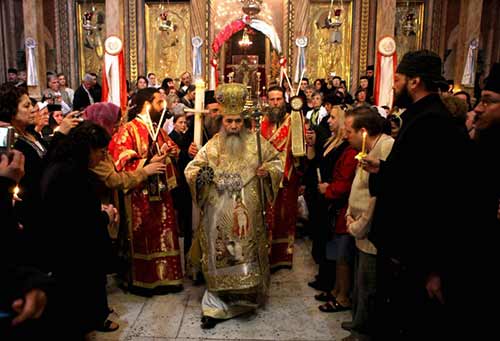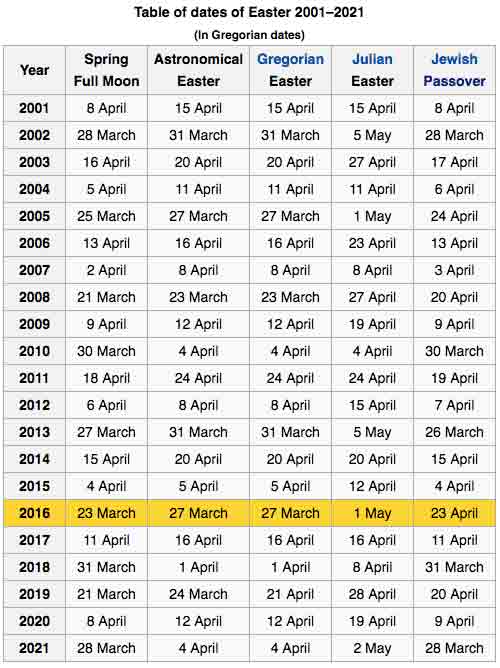
This year Eastern Orthodox Easter Day falls on May 1. Western Easter Day was on March 27.
Both East and West follow the Nicene calculation:
The first Sunday after the first full moon on or after the vernal equinox.
The Eastern Orthodox Church continues to follow the Julian calendar when calculating the date of Easter. The rest of Christianity uses the Gregorian calendar (introduced in 1582 with a new leap-year rule: centurial years are only leap years if they are exactly divisible by 400). Currently, the Julian calendar is 13 days behind the Gregorian.
The East also requires that Easter takes place after the Jewish Passover in order to maintain the Biblical sequence of Christ’s Passion. The West does not follow this, so, occasionally, Western Easter takes place either before or during the Jewish Passover.
The West does not use the actual date for the vernal equinox, but a fixed date (March 21), nor does it use the astronomical full moon but the “ecclesiastical moon,” based on tables created by the church.
Christians celebrated a common date for Easter between 325 and 1582, the latter being the date of the West’s change to the Gregorian calendar. The two dates, East and West, still coincide when the full moon following the equinox comes so late that it counts as the first full moon after 21 March in the Julian calendar as well as the Gregorian. This happened in 2010, 2011, 2014 and will happen in 2017 and 2034.
The World Council of Churches (WCC) proposed calculating Easter from the actual equinox and the full moon at the meridian of Jerusalem (the scene of Christ’s death and resurrection). The following table (source) shows this astronomical Easter in comparison to others (Passover commences at sunset preceding the date indicated):

I would be in favour of moving to the World Council of Churches proposal unless it risked ending up with three rather than two dates for Easter!
There is also a proposal to remove the association with the Moon (and hence links with the lunar Passover tradition) and fix the date of Easter to be conveniently the same Sunday each April. I would be saddened at such another loss of our connections with nature. There we stand, as we have for centuries, under the full moon lighting our Easter fire; with the full moon so wonderful, before electric light, for our human celebrations. I also do not think it is likely. You can read more about this movement here.
On the Eastern practice of having Easter after Jewish Passover: others (readers here) may know {or find (online) reference to} how ancient this tradition is, and how ingrained this is. If it is, it may prevent the simple solution of the WCC.
If you appreciated this post, do remember to like the liturgy facebook page, use the RSS feed, and sign up for a not-very-often email, …



The “Zonaras proviso”, the proposition that Easter must always come after the 15th of Nisan in the Rabbinic Jewish calendar, seems to have first been proposed by Ioannes Zonaras in the 12th century. It is an utter spurious rule. The Julian computus is self-consistent and makes no external reference to the Rabbinic or any other calendar. The reason the Julian Easter is not until May 1st this year is because the Julian moon is not full until Tuesday, April 26th. The lunar tables that place the full moon on this date were drawn up long before the Rabbinic Jewish calendar reached its present form.
Thanks so much, Timothy, for providing that important information. Blessings.
For a longer explanation of what the Orthodox Paschal date is and is not based on, see https://blogs.ancientfaith.com/roadsfromemmaus/2015/03/31/no-pascha-does-not-have-to-be-after-passover-and-other-orthodox-urban-legends/
Thanks, Peter. Blessings.
I suppose by Eastern Church that includes the Ethiopian Church which I have attended twice as well as the Greek Orthodox Church in Auckland. In terms of dates it is good to know with the calendar you provided when both East and West celebrate Easter.
Thanks, Rob. I, too, have had some wonderful celebrations with Ethiopians – unfortunately not yet in Ethiopia. Blessings.
England had (at least) two competing calculations for the date of Easter until the Synod of Whitby in 664 (and perhaps for some time afterwards). King Oswiu ruled in favour of the Roman method, over the British/Ionan method, when told that it was the method favoured by St. Peter. Oswiu reasoned that he didn’t want to arrive at the pearly gates only to be turned away because he had offended the holder of the keys. All of this may be pursued at length in the writings of Bede (e.g. De temporum ratione).
Bosco, have you seen the site http://thetridentinerite.blogspot.com/, which discusses the liturgical provisions of the books approve by Pius V in the wake of the Council of Trent? It posts the liturgies current for the day — according to the Julian calendar! Great fun. (And very learned.)
Thanks, Jesse. I knew of these English issues – thanks for adding them to this post. I’m not sure if I’ve fallen over that Tridentine site – at quick glance it does look to be more fun than a barrel of monkeys 🙂 Blessings.
Today (April 26th) is the 14th of Nisan in the Julian lunar calendar, the day of the Julian Paschal full moon. This, and not the Rabbinic feast of matzoth, is the only Passover that the Julian Easter must follow.
Nicæa I decided that there would be no relying on Jewish Passover; that doesn’t mean «after» or «avoiding». Both Julian and Gregorian computes follow this.
Another precision: things are not denominational, not even ritual. For instance, in Finland, the Orthodox Church follows the Gregorian calendar (both for mobile and fixed feasts), while, on the other side, the Churches of the Roman communion follow the Julian calendar in some Eastern countries.
So, one should not speak of «Eastern Orthodox Easter», but rather: «Julian Easter».
Thanks for the helpful improvement, George. Blessings.